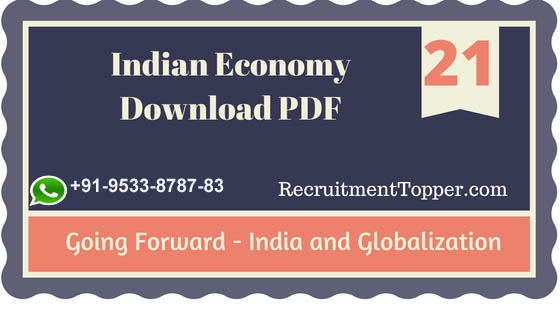Indian Economy Going Forward— India and Globalization Download PDF
Contents
Trade Strategies
We have previously discussed about concepts and objectives of globalization. But how did India go forward? Firstly, it was the Economic Reforms of 1991, which liberalized inflows of goods and services and also capital inflows as a signal of gradual and calibrated opening of the economy and at the same time a distinct thrust and focus on promotion of exports not that of ‘surpluses’ but catering to the global market in terms of demand, tastes and preferences.
As a strategy to promote exports there are two textbook strategies one which is the ‘export-led growth’ strategy and the other as the ‘growth-led exports’ strategy. An export- led growth strategy is of recent origin in the nineties, resulting out of the experience of the South-east Asian economies essentially comprising of Thailand, Malaysia, South Korea and Indonesia in the late eighties add early nineties. They were hailed as the ‘Asian tigers’.
In a short span of time, they were able to accelerate the rate of growth, increase per capita income providing for all round development of such economies, by a distinct openness, liberal foreign investment and a strong focus on exports. Thus, the strategy of exports increasing overall growth rates in such economies in a very short time, were also known as ‘butterfly economies’ which is smaller economies ability to grow and expand income at a fast pace in short time frame.
This strategy subsequently got questioned by the crisis which struck these economies in the late nineties, as ‘contagion effect’ (spreading across all these economies) plunging them into ‘currency crisis’. That is, complete erosion of faith in home currency (it will be discussed later).
It may be premature at this stage to say whether openness or the strategy was flawed but suffice it to say here that it was neither the openness nor the strategy followed but from other factors (it will be discussed later). As a strategy, an export-led growth requires re-orienting the domestic sector catering for exports, allowing liberal foreign investment and promoting exports from the country.
However, this is possible for smaller and homogeneous economies, lesser pressures of population or regional imbalances, lesser structural rigidities, relatively greater flexibility for such transformation. Larger economies like India given the size, large agrarian base, diversity, intense population pressure, large-scale poverty and unemployment, regional imbalances, structural rigidities and inflexibilities make such a strategy neither feasible, appropriate nor desirable.
The other growth-led export strategy is more relevant for economies like India. A strategy also followed by the developed countries in the previous years. This strategy is slow, time-consuming but sustainable in the long run. It allows for growth to increase by expansion of the manufacturing sector, allowing for their maturity and gradually emerging as competitive, finding foothold in global markets and thus increasing merchandise (goods) exports.
Such a strategy also provides an incentive mechanism for the natural growth of export- oriented industries well-integrated with the domestic economy. Both India as well as China have, however, blended both export-led growth and growth-led exports, as their strategy in their efforts at globalization.
Both have dedicated certain geographies within the domestic economy to cater exclusively for exports as part of export-led growth strategy and the remaining part of the economy following the growth-led export strategy. It is no longer the question about the strategy to adopt but that economies have to have a distinct openness and exports both integral to growth of economies in future.

Leave a Reply